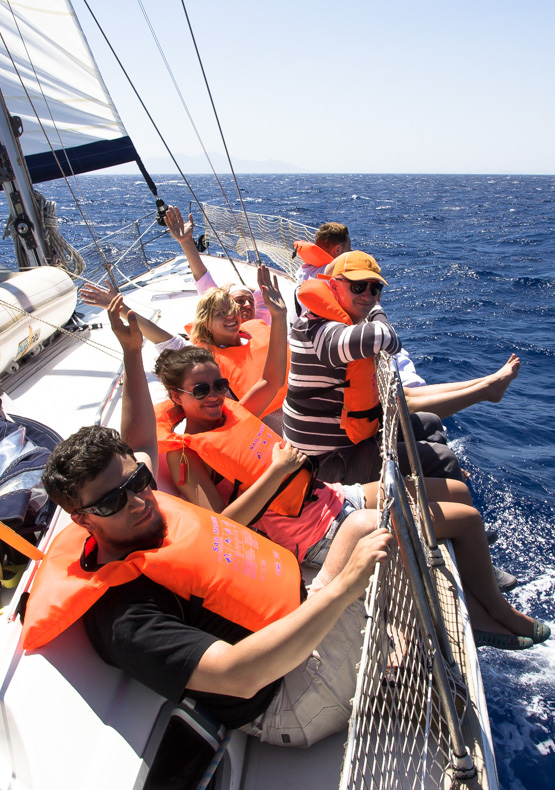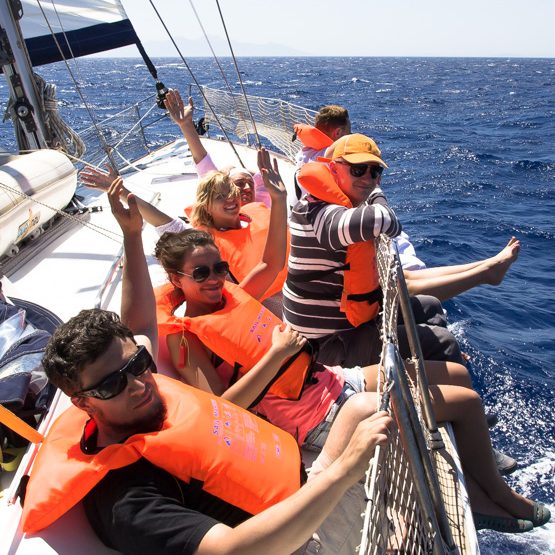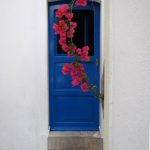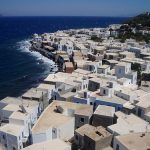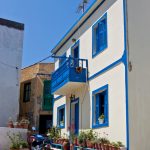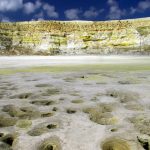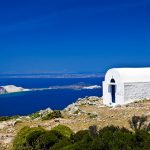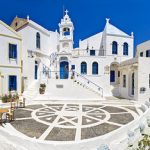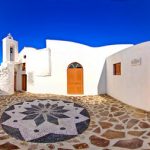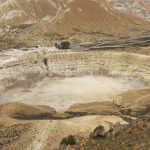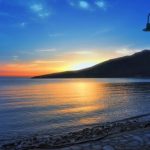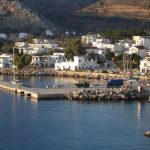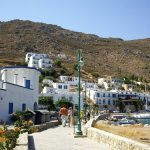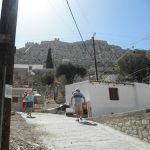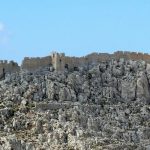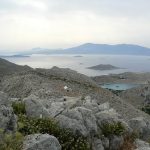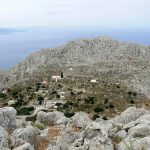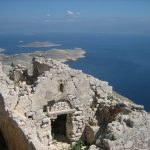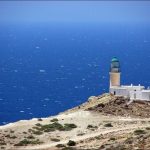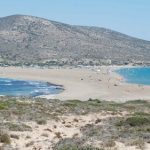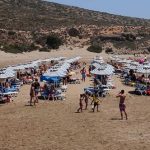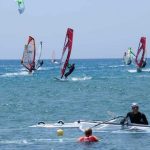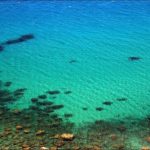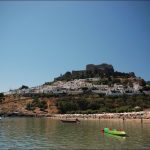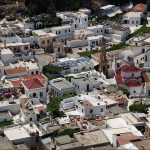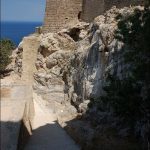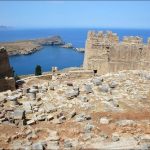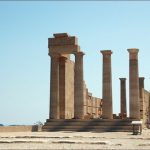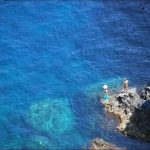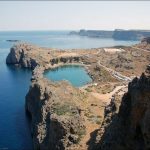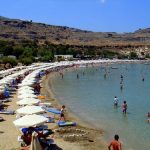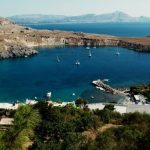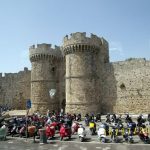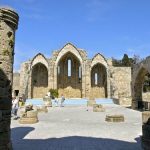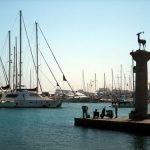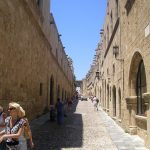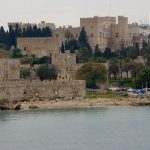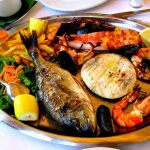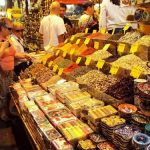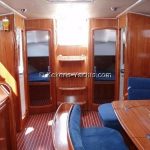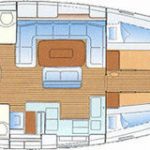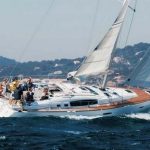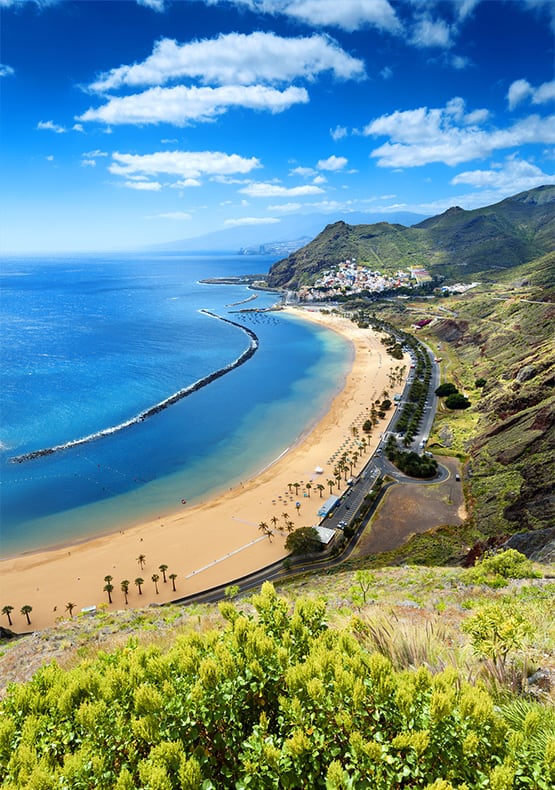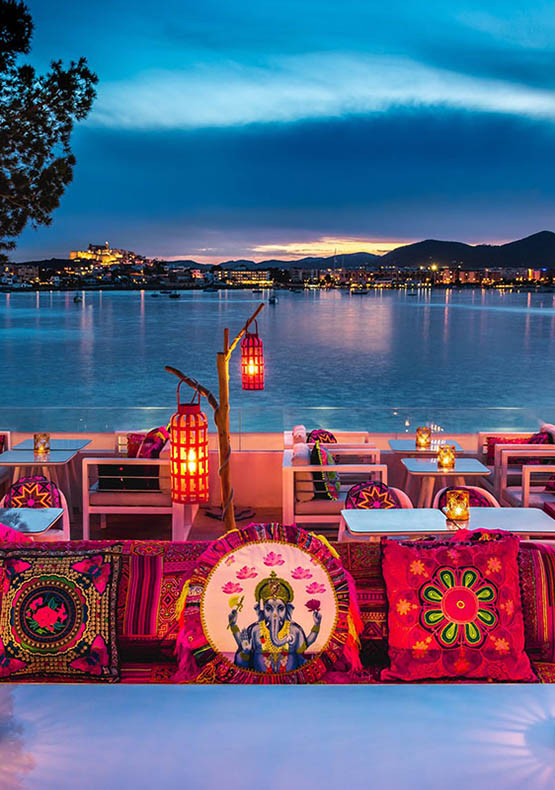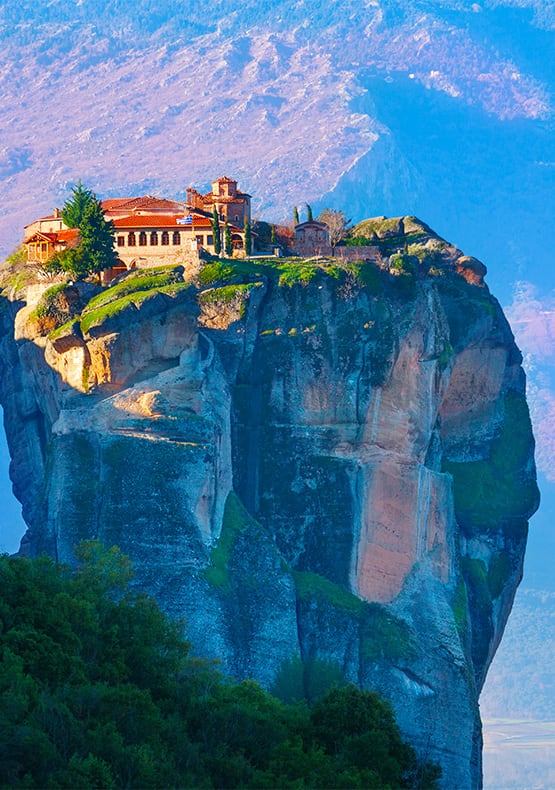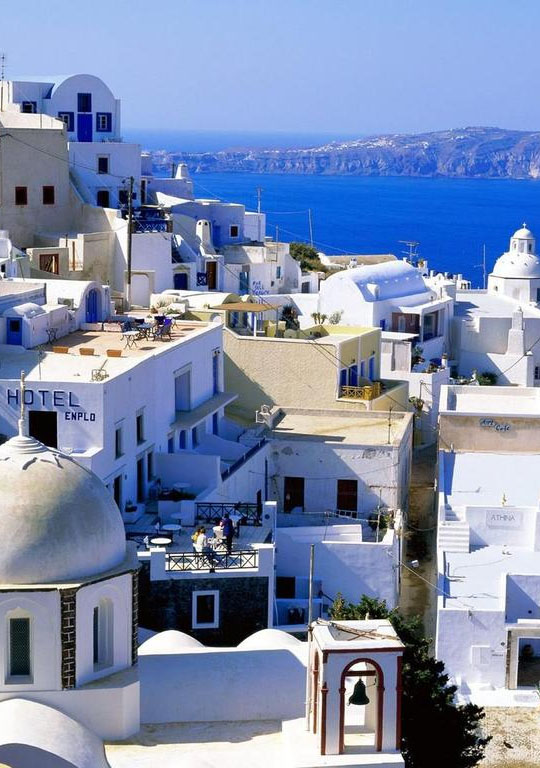A unique cruise for small and medium business leaders to five magnificent Greek islands with the opportunity to receive guerrilla marketing coaching from marketing guru Alexander Levitas. We depart from Rhodes.
Route map
Description of the region
Rhodes is the largest island in the Dodecanese. Its landscape is varied, from mountainous along the coast to wooded inland. The island's capital of the same name actually consists of a new town with modern buildings and hotels, an ancient city founded in 408, where the ruins of the temples of Zeus, Athena Pallas and Apollo, a stadium, a gymnasium and a theater have been preserved, and a medieval town.
According to legend, the Three Graces were born on the charming island of Symi. The coastal landscape changes from steep mountains to sandy beaches with small bays. Since time immemorial, the island has been famous for its shipbuilders and sponge divers. The main attractions of the island are the magnificent sandy beaches and the Monastery of Archangel Michael, built in the 18th century, with magnificent frescoes and iconostases.
The small volcanic island of Nisyros lies between Kos and Tilos. The volcanic, lunar-like landscape is combined with lush vegetation. According to legend, the island was once connected to Kos, but Poseidon split it into two during a battle with the Titan. Nisyros is an open geological park with wonderful hot springs, an impressive volcano, excellent beaches. The capital and port of Mandraki with its charming white houses, where you can climb the mountain and see the majestic castle-fortress of Spiliani, built by the knights in 1314.
The small island of Tilos attracts paleontology enthusiasts, where mammoth remains were found in one of the caves. The island's capital, Megalo Chorio (the "big village"), is built as an amphitheater on a hillside with a knight's castle towering over it. The city is built on the site of an ancient city, fragments of which can be seen among ordinary houses.
The small, mountainous island of Halki has been inhabited since ancient times. Apparently, the island got its name from the copper ore (halkos). On the southeast coast of the island is the capital and port of Halki, with the church of St. Nicholas, built in 1861, whose majestic bell tower rises above the surrounding houses. Take time to explore the charming castle and the ruins of the ancient Acropolis.
Navigation conditions
The Dodecanese are considered the warmest region of Greece, where you can go yachting from the beginning of April to the end of October and even November. North-east winds prevail, which are less strong than in the open Aegean Sea. In September and spring months, the winds are weaker and blow from the south-east.
Marina Mandraki in Rhodes is located in the old port of Rhodes, in the northernmost part of the island, below the medieval castle and opposite the town's market square. The marina has water, fuel, showers/toilets. Restaurants and supermarkets are within walking distance of the marina.
You can also fly to Rhodes from Athens by domestic flights (1 hour – 1 hour 20 minutes) or take a ferry from Piraeus (12 hours).
Program
Day one: 02.08.2014 - Rodes
- 14.00-16.00 — Gathering of participants at Mandraki Marina (Rhodes). Introduction.
- 16.00-18.00 — Yacht acceptance. Joint food shopping.
- 18.00-19.00 — Check-in on the yacht.
- 19.00-22.00 — Welcome Party, overnight stay in the marina.
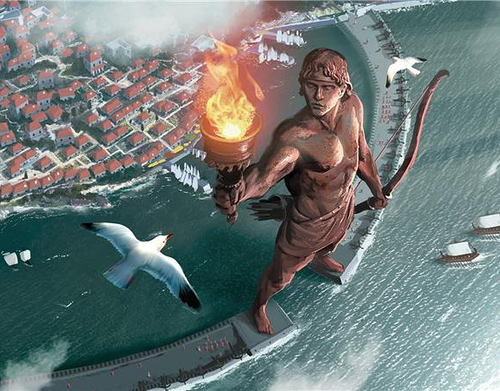
Day two: 03.08.2014 - Nisos Simi
Rodes – Nisos Simi (32 nm)
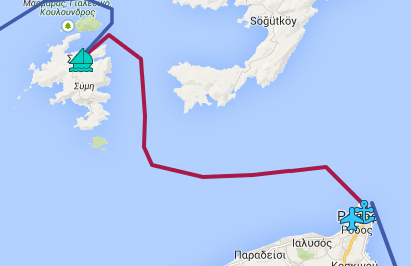
Almost the entire population is concentrated in the town of the same name in the north of the island, which arose near a medieval Byzantine fortification. There are a large number of monasteries and chapels on the island (about 200). The most famous of them is the Panormitis Monastery, dedicated to St. Michael, located on the southern coast of the island.
The dima of Symi also includes the nearby uninhabited islands of Ninos, Hondros, Diavates, Galesino, Marmaras, Kouloundros and Seskli.
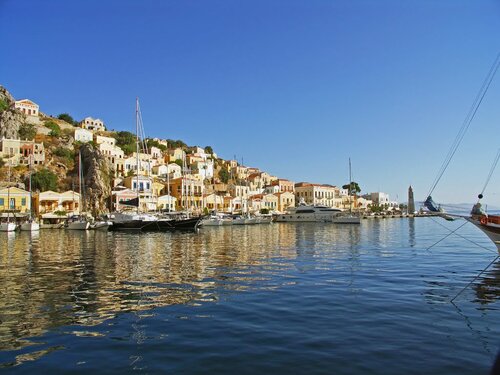
In the past, the island belonged successively to the Persians, Macedonians, Romans, Byzantines, the Ottoman Empire and played a significant role in the trade and economic relations of this part of the Mediterranean. The most developed industries on Symi were shipbuilding - due to their speed, ships built in local shipyards were purchased by the Turkish maritime postal service, as well as the extraction of sea sponges. At the end of the 19th century, the population of the island was 30 thousand people. Currently, the main occupations of the inhabitants are serving tourists and fishing.
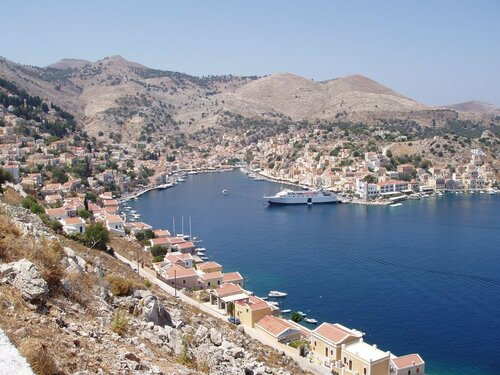
After World War I, the island belonged to Italy, and was occupied by German troops in 1943-1945. Since 1947, it has been part of Greece.
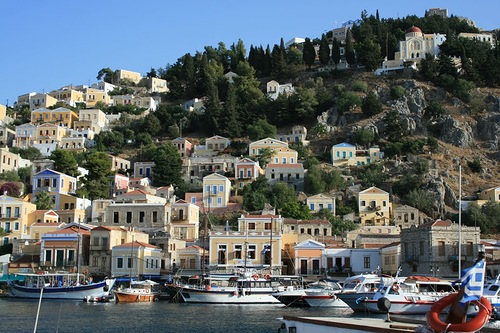
Day three: 04.08.2014 - Nisos Nisyros
Nisos Simi – Nisos Nisyros (47 n.m.)
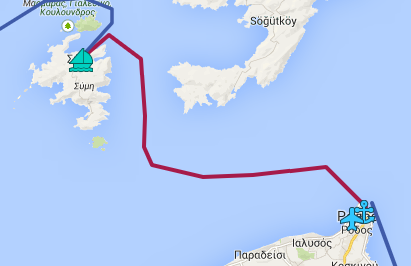
Tourists who have visited Nisyros are left very impressed by the volcanic craters with hot earth under their feet, and by the snow-white capital and the only city on the island, and by the islanders who live peacefully on the volcano.
General information
There is a legend about the island of Nisyros in ancient Greek mythology: Poseidon was chasing the giant Polyvotis, broke off a huge piece of the island of Kos with his trident and threw it at the giant. Polyvotis was crushed to the bottom of the sea, and never got out. He tossed and turned there, sighed - and that's how the earth rumbled.
The island of Nisyros covers an area of 41 square kilometers and is located in the Aegean Sea, between the islands of Tilos and Kos. The island is volcanic, has a round shape, and there is a "dormant" volcano, so the soil of Nisyros is rich in minerals, which in turn determined the composition of the flora and fauna, unique to the Aegean islands.
The islanders live mainly from pumice mining and tourism; about a thousand people live permanently on Nikosyros, mainly in the only town on the entire island – Mandraki.
Sights of Nisyros
Stefanos Volcano – the volcano has been dormant for a long time, but still “breathes”. The crater depth is about 30 meters. There are five craters on the island, all of them, together with Stefanes, make up the Lakki plateau, which appeared after a volcanic explosion in the middle of the 16th century. A visit to the plateau and a descent to the craters make a strong impression on tourists, here they feel the hot breath of the volcano: steam bursts out from under the ground, rumbling sounds are heard, and a sharp smell of hydrogen sulfide is felt. Most tourists go to the island precisely to visit the craters and see the local “lunar” landscapes.
The village of Nikea – is located at an altitude of four hundred meters, above the crater of the Stefanos volcano.
The city of Mandraki – the city itself is a landmark. Especially its historical part with narrow streets where the roofs of houses touch and mosaic sidewalks. Here is a castle built in the 14th century and a monastery of the 17th century. Above the port rises the ancient acropolis and the ruins of the ancient city of Nisyros.
Church of Our Lady of the Caves – rises above Mandraki together with the medieval fortress. The Virgin Mary is considered the patroness of the city, they say that if you light a candle and pray, the Virgin Mary will save you from childlessness.
Emborios Village - the name of the village translates as "Trading", and it was built in the depths of the island intentionally, so as not to be bothered by pirates. From here there are beautiful views of the volcano, nearby are the ruins of the Venetian fortress and the monastery of the Virgin Kira. In the vicinity of the village there is a cave, which is called a "natural sauna" because of the high temperature and humidity inside.
Pali village – is located about four kilometers from Mandraki, there is a beautiful sandy beach, the opportunity to practice water sports and try local fish dishes.
Day Four: 05.08.2014 - Nisos Chalki
Nisos Nisyros – Nisos Tilos – Nisos Chalki (50 nm)
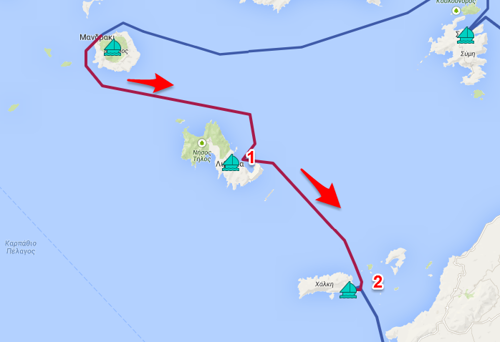
Tilos
Tilos was inhabited already in the Neolithic period. Traces of Minoan and then Mycenaean habitation have been found on the island. Around the 10th century BC, the Dorians appeared on the island. In the 5th century BC, the island joined the Athenian Maritime Union. In the 4th century BC, Tilos gained independence and began minting its own coins. In 42 BC, the island was captured by the Romans. Until 1310, when the island was captured by the Ioannites, Tilos belonged to Byzantium. After the defeat of the Ioannites by the Turks, the island was captured by the Ottoman Empire. Turkish rule lasted until 1912. As a result of the Italo-Turkish War, the island came under the control of Italy. After World War II, in 1948, it was reunited with Greece.
Chalky
A small mountainous island with rocky soil and sparse vegetation, natural sources of fresh water are virtually absent. Situated west of the island of Rhodes, the distance to the port of Rhodes is 65 km (35 nautical miles), the shortest distance is 9 km (5 nautical miles). The length of the coastline is about 40 km. The only settlement on the island is the town of Nimborio (Greek: Νημποριό); it is located on the east coast as an amphitheatre on the slopes of the mountains in a bay protected from the wind, the entrance to which is “covered” by a small island. In the interior of the island is the former “capital” of Halki - the village of Chorio (Greek: Χωριό), now abandoned. Halki is included in the list of protected natural areas within the Natura 2000 ecological network.
According to one version, the name of the island comes from the Greek χαλκός - copper and is associated with the development of copper mines in antiquity, according to another version, from the Greek κάλχη or χάλκη - "violet, purple" (possibly associated with the extraction of purple-bearing mollusks here).
Greek myths name the Titans as the first inhabitants of Halki. According to archaeological data, the island was originally inhabited by the Pelasgians, who were successively replaced by the Carians, Dorians and Phoenicians.
There are about 360 churches and chapels on the island (i.e. more than inhabitants), the largest is the church of St. Nicholas in Nimborio (1861), which stands out among all the buildings with its majestic bell tower. Near the beach of Pontamos, not far from Nimborio, there is an ancient necropolis of rock-cut tombs; in 1931, during archaeological excavations, Italians discovered red-figure ceramics from the 4th century BC and other household items. Many buildings in Nimborio are built in neoclassical style (the city hall with the Clock Tower, 19th century), some are examples of Italian architecture from the period between the world wars.
Chorio, the former "capital" of Chalki, was built inland to protect it from pirate raids and remained so until the 19th century. Its stone houses, standing amphitheatre-style on the surrounding hills, are reminiscent of Chalki's heyday. Above Chorio, on a steep coastal cliff, rise the ruins of a fortress of the Knights of St. John (the gate with the coat of arms of Grand Master Pierre d'Aubusson and the wall facing the island are well preserved). On the walls of the abandoned church of St. Nicholas (not to be confused with the church in Nimborio), located inside the fortress, you can find fragments of frescoes from the 15th and 17th centuries. In Nimborio there is a local history museum (λαογραφικό μουσείο), where you can see traditional clothes and household items of the Chalkians, as well as archaeological finds. The island has several beaches equipped for tourists. Every year from September 1 to 15 a festival is held.
Day Five: 06.08.2014 - Lindos
Nisos Chalki – Cape Prassonissi – Lindos (59 nm)
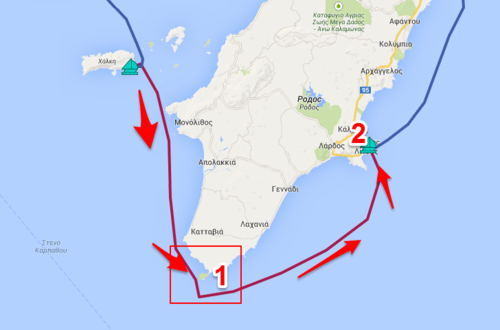
Cape Prasonisi
Cape Prasonisi is the southernmost part of the island of Rhodes, which is a small island connected to Rhodes in the summer by a sandy isthmus (500 m long and 100 m wide). It is located 92 km from the capital of the island and 40 km from Lindos.
Interestingly, Prasonisi means "green island" in Greek. Especially if you consider that the area here is mostly rocky and has virtually no vegetation. At the southernmost point of Prasonisi there is a functioning lighthouse (one of two lighthouses on the island of Rhodes), which was built back in 1890.
The island of Rhodes is washed by two seas – the Mediterranean and the Aegean, and Prasonisi is a truly unique place (the only such place in Greece). In winter, the waters of both seas join, flooding the sandy spit, and turning Cape Prasonisi into a small island. In summer, the sea waters part, and an excellent sandy beach is formed between two bays with crystal clear water.
With constant strong winds that almost never stop blowing, this place is a paradise for windsurfers and kitesurfers, and is ideal for both professionals and beginners. The excellent waves of the Aegean Sea will appeal to professional surfers, while the calmer Mediterranean is perfect for beginners. Prasonisi has two surf schools where you can hire an instructor for lessons and rent excellent equipment. The peak season here is in July-August.
Every year Prasonisi is visited by a huge number of windsurfers and kitesurfers from all over the world.
Prasonisi Lighthouse. Built in 1890. Performance characteristics: focal plane 61m (200f); four white flashes (5 seconds apart) every 30 seconds; structure — 14m high masonry tower (including lantern and portico), rising from a 1-storey lighthouse keeper's house; shipping notation — E4756; NGA 20388.
Day Six: 07.08.2014 - Lindos
Lindos is a town located on Cape Crana, in the southeast of the island of Rhodes in Greece.
The city of Lindos is divided into two parts: the Acropolis or Kastro (the Crusader castle) and the lower town, built in a distinctive style. The characteristic features of this style are the black and white mosaic courtyards and the carved stone door frames of the houses.
In the center of the city stands the Byzantine church of Panagia with tiled domes and an elegant bell tower. The church was built in the 10th century, but was rebuilt at the end of the 15th century. The frescoes date back to the second half of the 18th century.
The Acropolis, built in the 4th century BC, rises on a cliff above the city. Only columns remain of the Temple of Athena Lindia. In the 13th century, the Knights of St. John fortified the Acropolis with crenellated walls and built the Church of St. John inside.
On the way to the acropolis, you can visit the Pantheon, a museum of wax figures of mythological heroes and Greek gods. Also pay attention to the ancient relief of a ship, a combat trireme, carved into the rock.
Acropolis of Lindos.
The height of the mountain is 125 meters. One of the most sacred places of the ancient world. Temple of Athena Lindia (4th century BC)
Lindos is a very hot place and if you go to the Acropolis in the summer, stock up on water! Cars are prohibited in the city - it's a long way to go. On the road to the Acropolis they sell Lindian lace.
For most visitors to Rhodes, the most impressive place is the small town of Lindos, located on the east coast of the island, about 50 km from the city of Rhodes. An impregnable knight's castle, ancient Greek temples, ancient tombs, many other ruins, magnificent clean beaches (sand and rock) in beautiful bays, a cozy and quiet modern town - all this can be found here.
“Outsiders” are prohibited from entering the city by car - the streets are too narrow.
The first excavations were carried out on Lindos in 1900-1914 by the Carlsberg Institute of Denmark. The area of the Acropolis was excavated down to the stone foundation, the foundations of all buildings and structures that had ever existed here were revealed. During the Italian occupation (1912-1914) intensive restoration work was carried out. In many sources the word /restoration/ is in quotation marks because the methods used for restoration were too crude. At present, restoration work is also underway on ancient buildings.
According to myths, the cult of Athena Lindia was ancient Greek, but according to some archaeological finds, this cult arose even earlier. In the 9th century BC, the ruler of Lindos Cleobulos only revived the forgotten cult, building a temple on the foundations of an older temple. Even though the cult of Zeus began to be popularized in the 3rd century, Athena retained her position as the patron goddess of the city in Lindos.
Day Seven: 08.08.2014 - Rodes
Lindos – Rodes (30 n.m.)
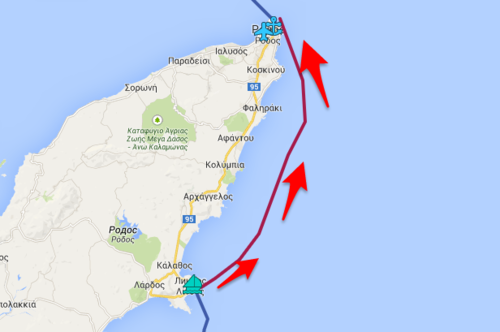
- 12.00-15.00 – Return to Rhodes.
- 15.00-20.00 — Walk around the city.
- 21.00 – Farewell dinner.
Rhodes
Rhodes is a famous resort with an excellently developed infrastructure and a rich history, founded by the Greeks in ancient times. It is divided into the Old Town - the historical center with most of the attractions, modern quarters located to the north, which include the port of Mandraki, and the fashionable Elli Beach with a beautiful promenade and some of the best hotels in Rhodes. The Acropolis on Mount Monte Smith, 2 km south of the Old Town, can also be distinguished as a separate area.
How to get there
14 kilometers from the city, on the eastern part of the coast, is the only airport on the entire island, Diagora. You can get from it to Rhodes by taxi or bus. In Rhodes itself, the Old Town is of greatest interest, and it is best to move around it on foot.
There are about 200 streets in the city that don't even have names, so check the map often to avoid getting lost.
A little history of Rhodes
Ancient Rhodes was founded in the 4th century BC as a result of the unification of Ialysia, Lindus and Camiros - three large city-states that existed on the island at that time.
The city was built in the northernmost part of the island, from where it was most convenient to observe ships in the Aegean Sea.
700 years after its foundation, the city was annexed by the Byzantine Empire and became the capital of one of the Byzantine themes. At that time, Rhodes was the residence of the Orthodox metropolitan and an extremely important military base. Another hundred years later, it was severely damaged by an earthquake and noticeably decreased in size. The Byzantine era lasted almost a thousand years and gave the city many Orthodox churches.
At the beginning of the 14th century, the Knights of Ionia came to Rhodes and the city became the center of the Order of St. John. During this period, Rhodes began to resemble other medieval cities.
Another 200 years later, the city was captured by the army of Mohammed the Great, and all the Greeks were expelled. The city, obviously, seemed convenient to the Turks in the form it had achieved by their arrival, so that the period of their rule brought practically nothing new to the external appearance of Rhodes. And at the beginning of the last century, the Turks were replaced by the Italians, who almost completely destroyed all traces of the previous owners' presence there.
Climate in Rhodes

Hotels in Rhodes
Hotels in the city of Rhodes are located both on the first coastline and in the center of the settlement, which should not be considered a disadvantage. Thanks to the crazy amount of historical "excursion", you can stay in a room with a view, say, of the Byzantine Church, the Suleiman Mosque or the Temple of Aphrodite. Those who cannot imagine life without underwater fauna should stay in the Cactus, Siravast and Ibiscus hotels - there is a large aquarium in the immediate vicinity. The most prestigious hotels of the resort stretch along the Elli Beach embankment.
Entertainment, excursions and attractions of the city of Rhodes
In the Middle Ages, the city was almost completely rebuilt by the Knights of the Hospitaller Order, acquiring powerful fortress walls, palaces of the Grand Masters and Admirals. The Suleiman Mosque with a beautiful library, the Sultan Mustafa Mosque and Turkish baths (still in operation) remained here as a "memory" of the Turks. It is definitely worth visiting the ancient port of Mandraki with the fortress of St. Nicholas, windmills and statues of deer.
The archaeological area on Mount Smith is interesting: a stadium from the 2nd century BC, a theater, and the ruins of the temples of Zeus Polneus, Athena Polias, and Apollo Pythian have been preserved there. From the top of the hill there is a wonderful view of the city and the sea. Other attractions include the churches of St. George and St. Paraskeva Pyatnitsa, the largest Catholic church in Rhodes – the Church of the Virgin Mary Chora, and the Byzantine Trinity Church.
It is also definitely worth visiting the famous Butterfly Valley near the capital. There, in natural conditions, among groves, streams and waterfalls, live thousands of these spectacular insects.
Socrates Street
One of the most interesting places in the city is Socrates Street. It runs from the Suleiman Mosque to the east, with bazaars on either side. Walking along this street, you will see the Archbishop's Palace, located on the square of the same name, the Commercial Tribunal, the Sea Gate and the absolutely charming Sea Horse Fountain. The street passes the luxurious Suleiman Baths (where you can not only admire the rich interior decoration, but also use them for their intended purpose) and the Sultan Mustafa Mosque. In the southern part, the street leads to a network of narrow alleys that can take you to Pythagoras Street, where the oldest mosque in the city is located - the Ibrahim Pasha Mosque, built in the 16th century - and several less ancient ones. Next to Socrates Street is also Fanourios Street, where you can see a small Orthodox church, Agios Fanourios, part of which is located underground.
In the Middle Ages, the city was almost completely rebuilt by the Knights of the Hospitaller Order, acquiring powerful fortress walls, palaces of the Grand Masters and Admirals.
Palace of the Grand Masters
At the very end of the Street of the Knights is the Palace of the Grand Masters, located at the highest point of the city. It was badly damaged at the very beginning of the Turkish era, during the siege, and was almost "finished off" by the explosion that occurred at its end - and then recreated by the Italians based on surviving drawings. On the territory of the palace are the Artillery Gate, through which one could get to the city wall, and an amazingly beautiful clock tower, built in the century before last.
City museums
Perhaps the best museum in the city is the Archaeological Museum. It is located on the territory of the Hospital of the Knights built in the 15th century, opposite the Church of the Order of St. John. In the more modern hall of the museum there is a small chapel and tombstones of the knights, and in the ancient hall there are many exhibits found throughout the island. The greatest attention of visitors is attracted by two statues of the 6th century BC, a funerary stele created a century later, and statues of two goddesses - Aphrodite and Venus. In addition, the museum has a large collection of antique vases.
There is also another very interesting museum here - the Aquarium, which was founded in the 30s of the last century. Here you can see a huge number of inhabitants of the Mediterranean Sea, both living in a habitat close to their natural habitat and preserved in embalmed form.
Rhodes cuisine
The cuisine of Rhodes is not much different from that which is common in Greece itself. In Rhodes you can try amazingly tasty and healthy Greek dishes.
The cuisine is based on the use of only high-quality products in cooking, with an emphasis on fresh vegetables, herbs and seafood.
All this is generously seasoned with all kinds of spices and olive oil.
They also drink a lot of coffee here, which is traditionally served with a glass of cold water.
Restaurants, stylized medieval establishments and captain's houses.
Day Eight: 09.08.2014 - End of the Cruise
- 08.00 — cabins are cleared.
- 09.00 — End of the cruise and farewell to the participants.
What's included in the price
- Accommodation on the yacht: one berth in a double cabin;
- Services of a Russian-speaking skipper;
- Fuel;
- Marina berths;
- Photo and video shooting;
- Additional yacht insurance;
- Yacht cleaning and bed linen;
- Internet Wi-Fi;
- Additional yacht insurance;
Additional expenses:
- Personal insurance and visa (approx. 80 EUR);
- Flight/transfer (direct flights St. Petersburg-Rhodes round trip - about 400 EUR);
- Meals on the yacht (purchased jointly, the amount is divided among all participants) (about 100 EUR);
- Visiting bars and restaurants (individually);
- Business coaching by Alexander Levitas (number of applications is limited - upon request);
- Refundable security deposit for the yacht 4000 EUR, divided among the entire crew (refundable in full if there is no damage to the yacht or other property on board during the cruise) - 450 EUR per participant.
Transport
The cruise will take place on several (two or three, depending on the number of participants) modern five-cabin sailing yachts Bavaria 50. The number of showers and toilets on each yacht is 3. The yacht has a gas stove, sink, refrigerator, Wi-Fi Internet, life raft, rubber dinghy, modern navigation equipment.
The core of the participants has been formed. We recommend going on a trip with a friend (girlfriend), so that you can settle in the same cabin (in this case, a discount of 10% is provided). If necessary, the organizers will help you with visa processing and purchasing air tickets. On July 25, 2014, a meeting of the St. Petersburg cruise participants will take place in the Andante restaurant.
The meeting will take place at 19.30 at the address: Saint Petersburg, Mytninskaya embankment, 3A. The restaurant has a separate parking lot.
No experience of participating in such cruises is required!
